Design Help for Small Classrooms
Join Our Community
Access this resource now. Get up to three resources every month for free.
Choose from thousands of articles, lessons, guides, videos, and printables.

We have inhabited many classrooms throughout the years, and none of them felt overly spacious. In fact, the words “This is the smallest classroom” have been uttered from our mouths on more than one occasion. It is no wonder we think they are small. When we step back into our classrooms after a summer break, our rooms are filled with the furniture the district provides: 28–33 student desks, a teacher desk, bookshelves, file cabinets, and so on. Once all the desks are arranged, there is little space left for anything else to happen.
After many years of setting up our classrooms and being frustrated with the lack of space, we decided to do something about it. One spring we visited Nancy Paulson, a teacher in a neighboring school district, to watch her teach guided reading. We came away with a new paradigm for classroom setup. She had transformed her institutional space into a space of learning and living. She used her furniture differently from how we did. She had a mix of desks and tables spread throughout her room, not just in the middle, as we typically set them. The feeling we got when stepping into the room was that students were comfortable, highly engaged, and using every corner of the space.
Our minds were opened wide. It was like taking the lid off a box that had been closed for too long. We had seen how it could be and began to question every piece of furniture, its placement, and its purpose for supporting student learning and teaching. We have reflected on that visit often.
Here are five essentials to transforming our rooms:
- Question each piece of furniture’s purpose and function. Does it help a student or students in their learning?
- Get rid of as much “stuff” as possible. Stuff takes up important space in small rooms. Instead of hoarding things we might need someday, we pass it on.
- Consider students’ learning styles. Some students like to sit at desks, some sit on the floor, and some like to lie down. Provide a few alternative spots to begin with and watch your students. If they gravitate to certain spots, move some large desks out and replace them with “nothing,” leaving open space.
- Teach students how to “live and learn” in the environment you set up. Many people wonder how students can write if they are not at a desk or what do they do when they work on an art project. It’s simple. We teach students how to be successful in the room, just as we taught them how to be successful when sitting at desks.
- Sit back and watch a few of the videos that are linked in the right column, letting your mind open wide to the possibility of transforming your “small classroom” into one that has space for all the living and learning for the year.





